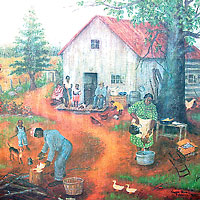Black history on display
By Barbara Arntsen
Published in News on January 31, 2005 2:00 PM
A roomful of paintings, pictures, and other artifacts depicting black history are on display at the Wayne County Museum throughout February.
Sponsored by the Martin Luther King Jr. Committee, the display on the second floor of the museum combines local and national history.
Newspaper clippings from past News-Argus editions tell the story of blacks in Wayne County, from the first black police officers hired to the desegregation of the public schools.

News-Argus/Barbara Arntsen
This painting by Queene Stovall shows a day in the life of a black farm family.
Sometimes the past seems to blur with the present. A 1963 headline reads: "Race, politics and city schools."
LaTerrie Ward, director of the city's Community Affairs department and a member of the committee, said the headline prompted a comment from one visitor about its timeliness.
"They said they thought the exhibit was about things from the past," she said. "But they thought the headline looked like something from yesterday's headlines."
A corner diorama shows pictures of Cherry Hospital, when it was an asylum for the "colored insane."
Established in 1880 as the Asylum for Colored Insane, the hospital served the entire black population of the state for its first 85 years. The name was later changed to Goldsboro State Hospital and in 1961 the name was changed again to Cherry Hospital in honor of Gov. Gregg Cherry.
In 1965, the hospital desegregated.
There are also pictures from the Goldsboro Training School, which opened in 1957 as the first institution for black mentally retarded citizens.
The name of the school was later changed to the O'Berry Center in memory of Sen. Thomas O'Berry.
In 1966, the O'Berry Center and other state mental retardation centers desegregated in response to the Civil rights Act of 1964.
Magazine articles from the 1950's and the 1960's are also on display, tracing the civil rights movement throughout the country.
There are also a number of artifacts including ancient kerosene lamps, cast iron frying pans, radios and an old ironing board with an iron.
In the middle of a room sits a small wooden chair, known as a "slave chair."
The purpose of the slave or butler's chair was to keep the servant in close proximity to the dining table so that he or she could be summoned quickly. The servant, though, was able to be out of sight due to the low height of the chair.
A series of photographs, displayed in the center of the room, shows various historical stereotypes of the African-American male.
Soundra Beamon, a Wayne County resident, put the photographs together as part of a graduate work project.
These white and black constructions show a range of stereotypes from watermelon-eating Sambo to the silly, shuffling and dim-witted Jim Crow.
The well-dressed black man carrying a serving tray is titled, "The Servant," and is meant to depict the inner conflicts white supremacists had with the changing status of blacks.
Ms. Beaumon even uses the word "coon" in the title of some of the photographs.
Ernest Hagan, she writes, was a black vaudeville performer, responsible for the wide use of "coon" through a popular song about black men.
Her well-dressed and flashy Zip Coon character reflects the changed view of the black man from a docile Sambo to a flamboyant and childish character.
Zip Coon, she writes, was seen as being contemptuous of whites and was viewed as a liar and a dandy.
In a book introducing her exhibition, Ms. Beamon writes that she is honored to present the images.
"I hope they will inform and also help to establish a place where a dialogue can begin so that the stereotypes will no longer be a part of our present."
The exhibit will be on display at the Wayne County Museum until the end of February. Museum hours of operation are Tuesday through Saturday, from 11 a.m. to 4 p.m.
